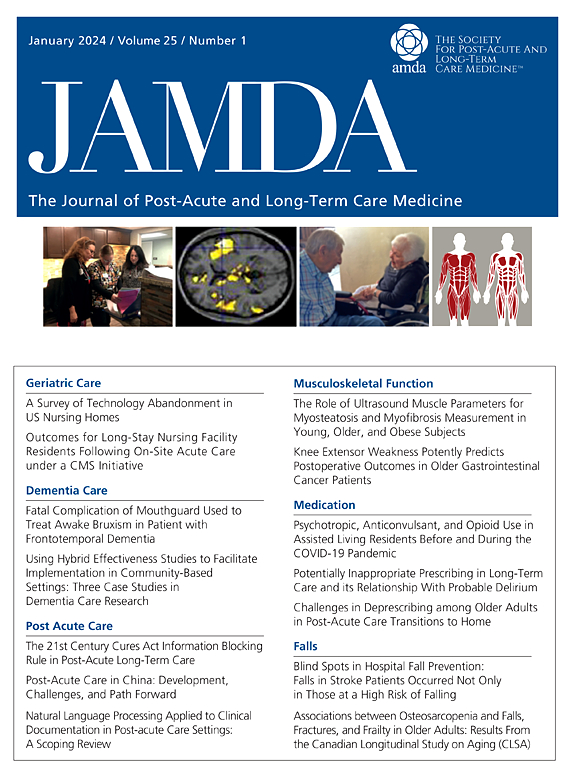Frailty Status and Dysphagia Trajectory Among Hospitalized Nursing Home Residents With Advanced Dementia
IF 3.8
2区 医学
Q2 GERIATRICS & GERONTOLOGY
Journal of the American Medical Directors Association
Pub Date : 2025-10-06
DOI:10.1016/j.jamda.2025.105860
引用次数: 0
Abstract
Objective
The objective of this analysis was to describe the association of dysphagia and frailty in persons living with dementia (PLWD) residing in skilled nursing facilities (SNFs) who experienced hospitalization.
Design
Retrospective cohort.
Setting and Participants
Long-stay US nursing home residents from 2012–2018 with advanced dementia who experienced a hospitalization.
Methods
Among the cohort, we captured Minimum Data Set (MDS) assessments of dysphagia before and after hospitalization. MDS items were also used to measure FRAIL-NH (fatigue, resistance, ambulation, incontinence, weight loss, nutritional approach, help with dressing) scale components before hospitalization. Adjusted analyses identified the risk for dysphagia in the pre-hospital cohort and new dysphagia in the post-hospital cohort according to pre-hospital frailty status.
Results
Among the pre-hospital cohort (n = 1,207,345), 85% (n = 1,026,736) were classified as frail. Almost half of the cohort (n = 562,574, 46.6%) was on a mechanically altered diet. Dysphagia frequency was higher among frail residents (6.2% vs 2.4% prefrail vs 1.1% nonfrail). After adjustment for demographics and comorbidities, frailty was associated with greater risk of dysphagia [adjusted incidence rate ratio (IRR), 3.97; 95% CI, 3.49–4.49]. Among those who survived hospitalization (n = 1,078,321), frailty was also associated with new dysphagia (adjusted IRR, 1.7; 95% CI, 1.6–1.7).
Conclusions and Implications
Frailty is associated with increased risk of dysphagia among PLWD residing in SNFs. Additionally, frail PLWD who experience hospitalization are at increased risk of new dysphagia. These results have important implications for designing interventions to decrease dysphagia among frail PLWD. Given the wide disparity between the rates of mechanically altered diets and dysphagia as determined by MDS items, additional validation studies on the use of the MDS in dysphagia are warranted.
老年痴呆症住院患者的虚弱状态和吞咽困难轨迹。
目的:本分析的目的是描述在熟练护理机构(snf)住院的痴呆症患者(PLWD)吞咽困难和虚弱的关系。设计:回顾性队列。环境和参与者:2012年至2018年期间长期居住在美国养老院的晚期痴呆症患者,他们曾住院治疗。方法:在队列中,我们收集住院前后吞咽困难的最小数据集(MDS)评估。MDS项目还用于住院前测量rail - nh(疲劳、阻力、行走、失禁、体重减轻、营养方法、帮助敷料)量表成分。根据院前虚弱状态,调整分析确定了院前队列中吞咽困难的风险和院后队列中新的吞咽困难的风险。结果:院前队列(N = 1,207,345)中,85% (N = 1,026,736)为体弱。几乎一半的队列(N = 562,574, 46.6%)采用机械改变的饮食。虚弱的居民中吞咽困难的频率更高(6.2% vs 2.4% vs 1.1%非虚弱)。在对人口统计学和合并症进行调整后,虚弱与吞咽困难的风险增加相关(调整后的发病率比[IRR], 3.97; 95% CI, 3.49-4.49)。在住院存活的患者中(N = 1,078,321),虚弱也与新的吞咽困难相关(调整IRR为1.7;95% CI为1.6-1.7)。结论和意义:在居住在snf的PLWD中,虚弱与吞咽困难的风险增加有关。此外,体弱多病的PLWD患者住院治疗后出现新的吞咽困难的风险增加。这些结果对设计干预措施以减少虚弱PLWD患者的吞咽困难具有重要意义。考虑到机械改变饮食和吞咽困难的比例之间的巨大差异,有必要对MDS在吞咽困难中的应用进行进一步的验证研究。
本文章由计算机程序翻译,如有差异,请以英文原文为准。
求助全文
约1分钟内获得全文
求助全文
来源期刊
CiteScore
11.10
自引率
6.60%
发文量
472
审稿时长
44 days
期刊介绍:
JAMDA, the official journal of AMDA - The Society for Post-Acute and Long-Term Care Medicine, is a leading peer-reviewed publication that offers practical information and research geared towards healthcare professionals in the post-acute and long-term care fields. It is also a valuable resource for policy-makers, organizational leaders, educators, and advocates.
The journal provides essential information for various healthcare professionals such as medical directors, attending physicians, nurses, consultant pharmacists, geriatric psychiatrists, nurse practitioners, physician assistants, physical and occupational therapists, social workers, and others involved in providing, overseeing, and promoting quality

 求助内容:
求助内容: 应助结果提醒方式:
应助结果提醒方式:


